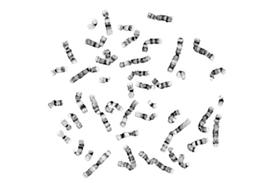Book chapters
If we describe DNA as the instruction manual for the machine which is the human body, our chromosomes are the 23 volumes into which the unmanageably long text of DNA is divided.
As women we have two copies of all 23 volumes. As men we have two copies of 22 and two different versions of the 23rd volume.
Volume 2 may contain more instructions than volume 15, but on average there are about 1,500 genes on each chromosome.
We can 'print out' the composition of our chromosomes in the form of a karyogram, which allows us to visualise defects at the chromosome level. By this we mean defects affecting large sections of DNA, which are (parts of) chromosomes that have been moved, duplicated or lost.
Following the instruction manual analogy, a karyogram shows whether:
- Our organism has all the volumes of the manual
- Whether large numbers of pages have been lost or misplaced
- Whether we have two copies of each volume rather than one too many or one too few
- There are no extra or missing chromosomes.
What it does not show is whether instructions are missing or incorrectly worded within a particular volume.
